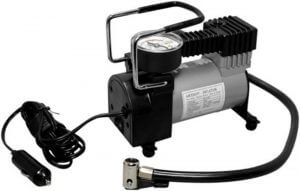A buyer’s guide for car tire inflator
A car tire inflator or air pump lengthens your car tires’ life and makes you a safer driver.
The truth is that your vehicle tires lose pressure even when they look all fine without any puncture or tear. Some subtle causes of tire pressure loss include mounting defects, wear of the valve stem, and temperature fluctuations.
And the effects of the pressure loss can vary from awful to horrendous. They include increased gas consumption, more frequent tire replacement and skidding on the road when you need to be in control.
It goes without saying that you need to regularly recharge your car tires with a portable inflator even when the TPMS hasn’t signaled a need for the same.
But how do you know the best portable air pump for your car tires?
Here is a checklist tips that you can use when purchasing the inflator.
(i) Power specs
A portable air compressor means that you’ll be using it both at home and while on the go, in camps, conferences, etc and you need to mind how you will be charging it in all the different places. Some tire inflators feature both AC and DC chargers such that you can charge it from the wall socket while at home and from your car DC source when you are on the road.
When it comes to DC charging in the car, cigarette lighter sockets reach a maximum of 15Amps thus it is important to ensure that the pump does not exceed 12V 15A otherwise the fuse will blow up.
(ii) Reliable pressure gauge
Some tire inflators do not have an inbuilt pressure indicator and you would have to rely on guesswork if you don’t have an external pressure gauge.
A good pressure gauge should have an accuracy of at least 1 unit and should preferably have multiple display units (PSI, BAR, KPA, etc), for convenience.
(iii) Automatic shutoff
Once you switch the inflator on, you may not like having to monitor the pressure as it rises so that you can switch it off at the set pressure.
And of course, there is the issue of human error and distractions.
A tire air pump with automatic shutoff function will switch off automatically when the set pressure is reached. This lets you concentrate on something else as the tire fills up.
(iv) Flashlight or emergency light
You may get a puncture in the middle of nowhere and process of connecting the pump may become difficult and even hazardous without a source of light. Most pumps come with an LED flashlight to illuminate the work area.
There are also some inflators that come with an emergency light that you can use to alert oncoming traffic.
(v) Duty cycle
Duty cycle or continuous working time of a pump is the time it takes for the pump to reach its maximum operating temperature, at which manual or automatic shutoff is needed to prevent damage.
A pump with a duty cycle shorter than the time it takes to inflate your four auto tires would frustrate you because you would have to shut it down midway.
20-30 minute continuous working time is recommendable for regular tire pressure top-ups. If the air compressor is fast enough, it would let you charge all your tires plus your other inflatables such as sports kit and air mattress.
(vi) Air flow rate
A pump’s air flow rate measured in CFM (cubic feet per minute) is a measure of its power, the amount of air it can pump per minute.
The higher the CFM the faster it inflates the car tires getting you back on the road in a jiffy. A pump with at least 0.5 CFM at 0 PSI can refill a tire in under 4 minutes and it is therefore recommendable.
(v) Size and weight
Your car trunk space is limited and therefore you should go for an inflator of a minimal size and weight as long as its performance is satisfactory.
It is worthwhile to consider pumps weighing 5 lbs or less.
(v) Vibration
As soon as you switch them on, some tire air pumps start running on the driveway and become a nuisance to neighbors.
To avoid this, check whether the pump has vibration absorbing function such as rubber feet.


